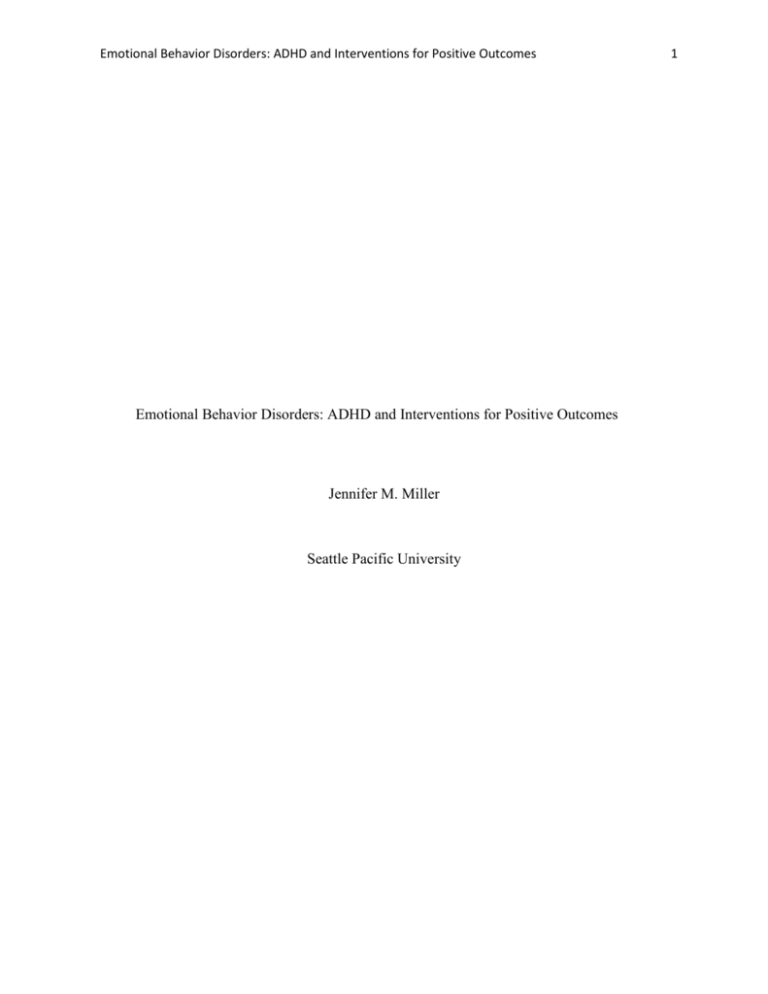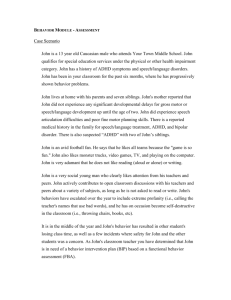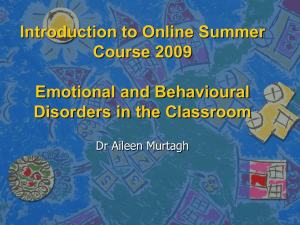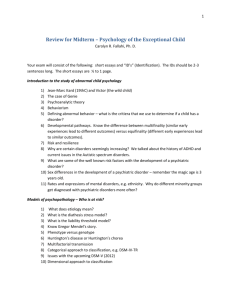EDSP_6644_Fall2014_Lit Review_Miller_Jennifer
advertisement

Emotional Behavior Disorders: ADHD and Interventions for Positive Outcomes Emotional Behavior Disorders: ADHD and Interventions for Positive Outcomes Jennifer M. Miller Seattle Pacific University 1 Emotional Behavior Disorders: ADHD and Interventions for Positive Outcomes 2 Emotional Behavior Disorders: ADHD and Interventions for Positive Outcomes Introduction Students that have learning disabilities and displaying problem behaviors comprise the population of students that is receiving special education services. It is important to take steps in the early stages of disruptive behavior because of the “important educational and mental-health implications” (Scott, Anderson & Spaulding, 2008). The research indicates that students that are identified with behavior problems have a higher risk for anxiety, depression and antisocial behavior (Scott, Anderson & Spaulding, 2008). One example of a behavior disorder is ADHD, which is commonly diagnosed during childhood. Behavior disorders are something a general education teacher will have to deal with and need formal training so that they can assist their students. Research ADHD is one of the most commonly diagnosed behavioral disorders of childhood. It is estimated that about two million Americans have ADHD. This disorder can have a negative impact on a student social, emotional and academic functioning. This is a disorder that is lifelong, and the symptoms appear over a course of time that includes impulsiveness, hyperactivity, and inattention. The main causes of ADHD are still unknown. However, there are two theories. The first has to with genetics and ADHD seems to run in families. The second theory had to do with exposure to toxins. Children that have a higher exposure rate tend to have higher rates of ADHD. It was thought that children would outgrow ADHD; however, new research has shown that this not the case. ADHD can continue into adulthood and have lasting Emotional Behavior Disorders: ADHD and Interventions for Positive Outcomes 3 effects. This behavior disorder has the greatest risk of interpersonal problems and educational functioning than any other disorder (Mattox & Harder, 2007). The importance of ADHD and diverse populations as has been overlooked. It would seem that students from the African American community had the highest rates of hyperactivity while Asian students had the lowest rates. The reason the so many African Americans are being diagnosed may have to do with their stressful and unpredictable environments. (Mattox & Harder, 2007). It is interesting to note that gender is also a factor. More boys than girls are tested for ADHD in childhood. Girls are not tested as much as boys for ADHD but can have a higher rate of depression and anxiety (Mattox & Harder, 2007). The main reason may have to do with the way girls and boys are socialized. The three best methods to treat ADHD are pharmacological, behavioral therapies and parent training. Studies have found that using both pharmacological and behavioral therapies help students be successful in the classroom. This also increases the chances of being more social and emotional functioning for a student with ADHD. Parent-training is behavior therapy that takes place in the home environment that brings about changes in behaviors. This model also strengthens the child’s bond with the parent. Parent training can be difficult in diverse populations because of the way these groups seek help. They tend not to go to professionals but rather seek help from family, neighbors, faith- based leaders. Understanding the way certain groups seek help could be a way to expand parent-training in community-based settings rather than a clinical settings (Mattox & Harder, 2007). Teachers are often the first to make referrals for ADHD-related assessments, and they spend the most time with students in the school setting. The school psychologist plays an Emotional Behavior Disorders: ADHD and Interventions for Positive Outcomes 4 important role because they perform the assessment and treatment for students with behavior disorders including medication management. The research was conducted discover the knowledge base of general educators, special education educators, and school psychologist in the state of Washington to verify the preparedness of each group when it comes to helping students with ADHD. Little research was completed on this topic, and it is important to know if teachers and school psychologist in the field have the proper training to assist students with ADHD. The reason is that the role teachers and the school psychologist play with students that have ADHD. The researchers were trying to find out three key points of information about professional knowledge of ADHD. Do special education teachers have more knowledge than general education teachers? Does school psychologist have more knowledge than the teachers? Do years in the field play an important factor when it came to helping students with ADHD? The researchers requested that 132 volunteers from various districts from Washington State participate in the survey. These volunteers had a broad range of experience so they could measure the knowledge of the school psychologists, special education teachers, and general education teachers (Weyandt 2009). The researchers used a questionnaire to collect the data they were seeking. The results were that special education teachers and general education teachers did have “accurate knowledge” but were limited in knowing all the facts when it came to ADHD. Teachers seemed to think many myths were real. It would seem that special education teachers did not receive any more training on the topic than the general education teachers and is an interesting discovery. Both groups expressed concern for teaching students with ADHD because of the lack of training, and more training needs to take place for the sake of the student (Weyand al, 2009). Teachers without proper training can lack confidence in their ability teach students Emotional Behavior Disorders: ADHD and Interventions for Positive Outcomes 5 with ADHD. (Weyandt e al., 2009). The second question was school psychologist knowledge was greater than teacher knowledge. The data collected supported that the school psychologist does have more knowledge about ADHD than teachers. This comes from considerable amount of training and experience. (Weyandt e al., 2009). The third question had to do with experience. It would seem that teachers and school psychologist with fewer years of experience tend to have more knowledge on the topic of ADHD. This would suggest that more training is taking place to better prepare professionals that enter the field. More research on this topic has been completed, and this has helped newer professionals gain the training they need prior to entering the field (Weyandt e al, 2009). Emotional Behavior Disorders (EBD) is defined by the same criteria that psychiatrists use. This includes deficit hyperactivity disorders (ADHD), oppositional defiant or conduct disorders (ODD or CD), depression, and mood disorders. Prevalence is a condition of being prevalent or common. Forness and Kim (2012) researched how many school-age children have an emotional or behavior disorder. From their research, it was discovered that the identification rate is slightly less than one percent of the student population. More than ever, special educators have a reason to collaborate much more with psychiatrists and other mental health professionals. The reason is that psychiatric diagnoses may prove to be more helpful for special educators. It is important to understand that the prevalence only shows a small window of time of EBD across children’s ages. There is also cumulative prevalence that is not studied as much, and this takes into account how many children ought to meet the criteria for a particular psychiatric disorder at any point in their life. Both types are important for special education teachers as it allows for planning of resources. However, these studies do have limits because they do not draw from a representative sample or measure the level of impairment (Forness & Kim, 2012). The Emotional Behavior Disorders: ADHD and Interventions for Positive Outcomes 6 research has shown that prevalence in the last four decades is ten percent in kindergarten, thirteen percent in elementary and sixteen in secondary. The overall prevalence is twenty-two percent across the age span (Forness & Kim, 2012). It is interesting to note that prevalence is also driven by income factors. In high-income communities have a prevalence of about eleven percent. In middle - and low- income families have a prevalence of eighteen to twenty- one percent. The authors do state that prevalence does not factor in racial or ethnic background (Forness & Kim, 2012). The significance of all this research is the impact on the general education classroom. Class size increases as grade level increases. This will also have an impact on teachers and the students in the general education classroom. The research has shown that the expected number of students that will have EBD in a general classroom will be from one to three in the elementary setting and three to five in the secondary setting. It should also be pointed out that students with EBD can be misdiagnosed with learning or speech disabilities (Forness & Kim, 2012). General education teachers can expect to receive some special education resources. However, the major issue is that special education teachers are trained to assist with a child’s learning problem rather than emotional or behavioral problems. There is a shared understanding not all students in the EBD category are receiving the resources they need to be successful. This gap can be felt by the general education teacher that makes it difficult for the teacher depending on the severity. The students in the “EBD category have been shown to have by far the worst outcomes of any of the major categories in special education” (Forness & Kim, 2012). Teachers may see that students in the early grades have social or academic problems, but many do not see this as an EBD even with no response to classroom management. It is important to prevention with classroom-wide positive behavioral Emotional Behavior Disorders: ADHD and Interventions for Positive Outcomes 7 support to enhance the response of all children in the class (Forness & Kim, 2012). If the problem persists for a particular student, the next step is functional behavioral assessment. In 1997, amendments were made to Individuals With Disabilities Education Act (IDEA) which included the use of functional behavioral assessment (FBA) in school settings. FBA is an approach that is an analytic method to improve behavioral outcomes for individuals with disabilities (Sugai, Lewis-Palmer, Hagen-Burk, 1999). In 2004, FBA was mandated by the federal government to help students with behavioral problems. FBA’s has extended to ADHD and other behavioral disorders. The research has shown that environmental events impact behavior. By taking a look at these behaviors and see the triggers, the outcomes for student success can be improved with a problem-solving strategy. FBA helps with collection of problem identification information, analysis, intervention planning and monitoring (Sugai, Lewis-Palmer, Hagen-Burk, 1999). FBA’s should be conducted by team that has direct experience with the student. The team needs to have behavioral expertise and competence to lead the FBA process. The behavioral expertise should be a school psychologists, school counselor or special educators. The administration should be involved with the FBA process to aid with personal and resources. Most importantly the student needs to be participating (Sugai, Lewis-Palmer, Hagen-Burk, 1999). Some of the main problems with FBA’s are certain educators at the school may not have knowledge about the FBA process. Staff may have knowledge but do not have enough fluency to be able to implement the process. It can be difficult to manage the process with a large number of students. It takes time to train professionals to be able to be effectively involved in the process. It is also important to clarify what is best practice and policy (Sugai, Lewis-Palmer, Hagen-Burk, 1999). To prevent problems during the FBA process, it is important for the Emotional Behavior Disorders: ADHD and Interventions for Positive Outcomes 8 behavior expert to decide who needs training and who will conduct the training (Scott, Anderson, Spaulding, 2008). It would be in the best interest of the team to have someone with extensive knowledge of behavior interventions to do the training of practitioners. The person that is sitting in as the behavioral specialist must have enough knowledge about Behavior Intervention Plan (BIP) strategies. This includes preventing and neutralizing the impact of setting event. Setting events are factors that make the problem more intense. The behavioral specialist must remove the events that trigger problem behaviors and add appropriate replacement behaviors. Teaching appropriate behaviors would include self-management, social skills, adaptive responses and removing events that maintain problem behaviors (Sugai, LewisPalmer, Hagen-Burk, 1999). FBA’s work best with the school has a school-wide and classroom management systems for all students and staff. It is important to not just have one person at the school that can play the role of the behavioral specialist. The first reason is logistical. One person is not able to handle many interventions adequately. The second reason is that the individual many have the skills or training of developing an effective intervention. Lastly, the individual may have other job duties, or they can take on new responsibilities that will result in the lack of services (Scott, Anderson, Spaulding, 2008). FBA’s should be conducted when it is hard to understand the problem behavior or when an intervention plan is needed to help the student. Once patterns are found, the intervention can begin. This starts with FBA by collecting information that includes interviews, archival reviews, and observations. There are two types of FBA’s, and the least time-consuming method should be used to understand the behavior. The team is trying to come up with functional hypothesis by asking the purpose of the behavior and why the student would engage in the behavior. The first type is efficient, and this only takes a few days. The second type of FBA is formal and is more Emotional Behavior Disorders: ADHD and Interventions for Positive Outcomes 9 comprehensive as the methods used to gather information differ. A formal FBA should be conducted if the team thinks that there will be harm to the student or to others. As well as if other attempts have not worked. There are no set rules for determining which FBA should be used. The problem behavior should guide the team is the most general rule (Scott, Anderson, Spaulding, 2008). Once the needs of the student are identified, the team works to develop an intervention plan. The intervention should also be just as balanced as the FBA. Interventions cannot take place until the team has a sound hypotheses statement. This helps the team arrange the environments and consequences in order to achieve more appropriate behavior. The team develops a replacement behavior plan in order to tell the team what will be taught. (Scott, Anderson, Spaulding, 2008). When students are using replacement behavior, it is important to at the functional outcomes is present each time. The outcomes need to be arranged by the team so that contingencies always have a functional outcome. It is important to provide the student with incentives for appropriate behavior that is desired. “The rule of thumb for both positive and negative contingencies is to stay as natural as possible and to use the least amount necessary to get the desired outcome “(Scott, Anderson, Spaulding, 2008). The final step is for the team to decide how the intervention will be documented and monitored. The data can be collected in various ways, but it must be accurate and regularly (Scott, Anderson, Spaulding, 2008). Along with FBA and interventions, students with EBD need positive classroom environment. Students that have EBD need tend to be noncompliant, aggressive and impulsive. For these students, it is important to create positive interactions so that students can build selfesteem and optimistic outcomes. Students with EBD’s have a difficult time in a school setting because what is valued is academic abilities and social skills. Students with externalizing Emotional Behavior Disorders: ADHD and Interventions for Positive Outcomes 10 behaviors are likely to deficient in both areas, and they do not have an affirmative experience while they are in a school setting. Without a positive outlook, it is difficult to be able to effectively problem solve and have academic success. EBD students are characterized as unmotivated and have limited educational choices. Many decisions are made for them due to the behavior problems. EBD students tend to have the highest dropout rate. (Jenson e al., 2004). Studies have been conducted on teacher behavior in the classroom. Teachers tend to focus on the negative behaviors instead of the positive behaviors of EBD students. Also, praise is lower for students with EBD than any other learning disability (Jenson e al., 2004). Creating a positive environment is not as easy as it sounds. It is important to have the three C’s in the classroom that includes a) academic content that is useful and interesting b) a cooperative learning environment in which the student feels safe c) choice in which student is asked to think about what they are doing (Jenson e al., 2004). Positive praise is not enough for students with EBD. The study showed that teachers also need motivational strategies and negative consequences. This gets harder to do as the student gets older. (Jenson e al., 2004). However, a positive classroom environment is the most effective way to help students with EBD. Implementation Students with behavior disorders such as ADHD are important to special education because as general education teachers will more to likely have a least one student in their classroom with EBD. As the research showed the average classroom can have from one to five students a year with EBD. It is important to know about the social and academic problems that can take place with students that have behavior problems. General education teacher’s behavior in the classroom with have a significant impact on students with EBD and it is important that a Emotional Behavior Disorders: ADHD and Interventions for Positive Outcomes 11 positive, and engaging classroom will help students with EBD. The research has also shown that it is important to make sure that general education teachers collaborate with special education teachers and school psychologist. The reasoning behind this is to help students with EBD to be successful as the dropout rate is higher than any other category in special education. This is an imperative topic for me because this year; I have two students with EBD. I see that interventions are the right path to take. For one of my students, an FBA and intervention have started to make an impact on this student, and he is turning the corner which has resulted in a positive outcome. This intervention was research based and conducted by a team. The other student, I have adjusted my behavior to increase positive outcomes and this small change has a great impact on his behavior in the general classroom setting. Researching other emotional behavior disorders would be a benefit for me as a general education teacher to have the greater knowledge about EBD. Conclusion Students with emotional, behavior disorders such as ADHD are becoming more common in the general classroom setting. It is important for general educators to have a greater understanding of EBD students so that they can take steps to ensure they are thriving in the classroom. EBD students need extra support that may include FBA and interventions. Positive learning environments help students learn how to behave in a school setting and increase their chance to be able to meet academic challenges and not become another statistic. Emotional Behavior Disorders: ADHD and Interventions for Positive Outcomes 12 References Forness, S.R., J., & Walker, H. M. (2012). Prevalence of Students with EBD: Impact on General Education. Beyond Behavior, 21(2), 3-10. Jenson, W., Olympia, D., Farley, M., & Clark, E. (2004). Positive Psychology and Externalizing Students in a Sea of Negativity. Psychology in the Schools, 41 (1), 67-79. Mattox, R., & Harder, J. (2007). Attention Deficit Hyperactivity Disorder (ADHD) and Divers Populations. Child & Adolescent Social Work Journal, 24 (2), 195-207. Scott, T., Anderson, C., & Spaulding, S. (2008). Strategies for Developing and Carrying Out Functional Assessment and Behavior Intervention Planning. Preventing School Failure, 52(3). Sugai, G., Lewis-Palmer, T., & Hagan-Burke, S. (1999). Overview Of The Functional Behavioral Assessment Process. Exceptionality, 149-160. Weyandt, L. L., Fulton, K.M., Schepman, S.B., Verdi, G.R., & Wilson, K. G. (2009). Assessment of Teacher and School Psychologist Knowledge of Attention-Deficit / Hyperactivity Disorder. Psychology In The Schools, 46 (10), 951-961









